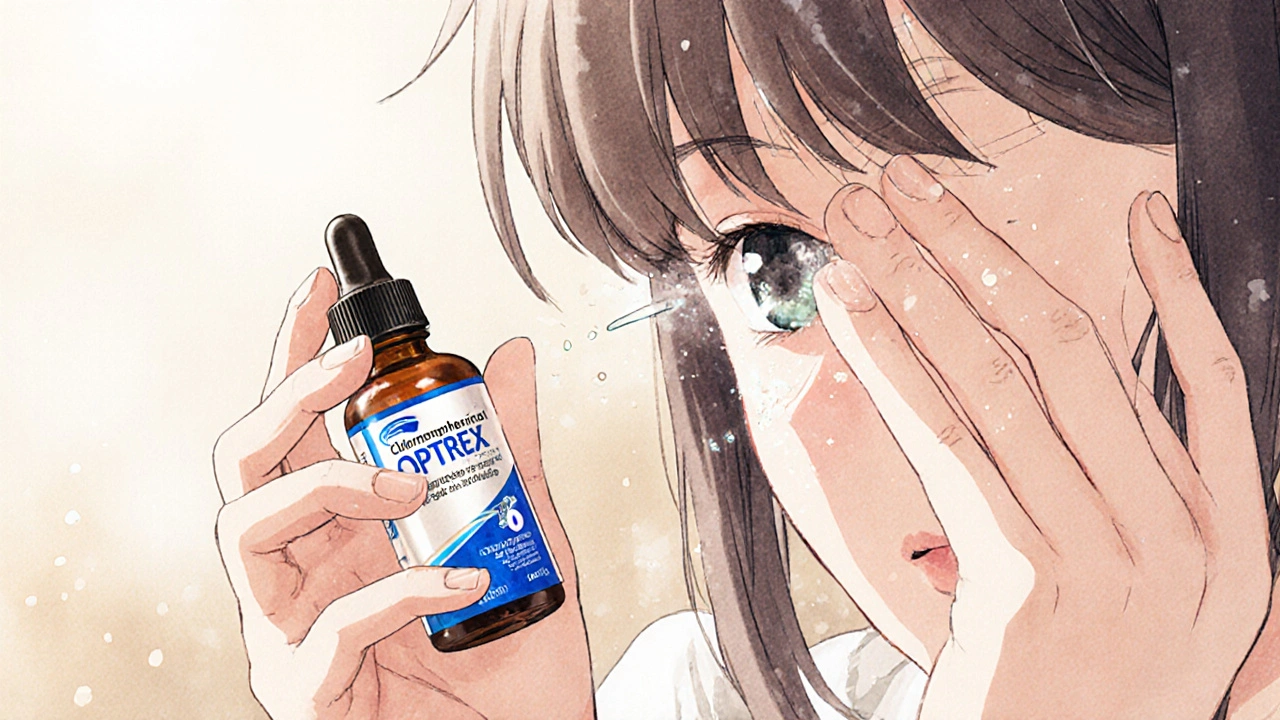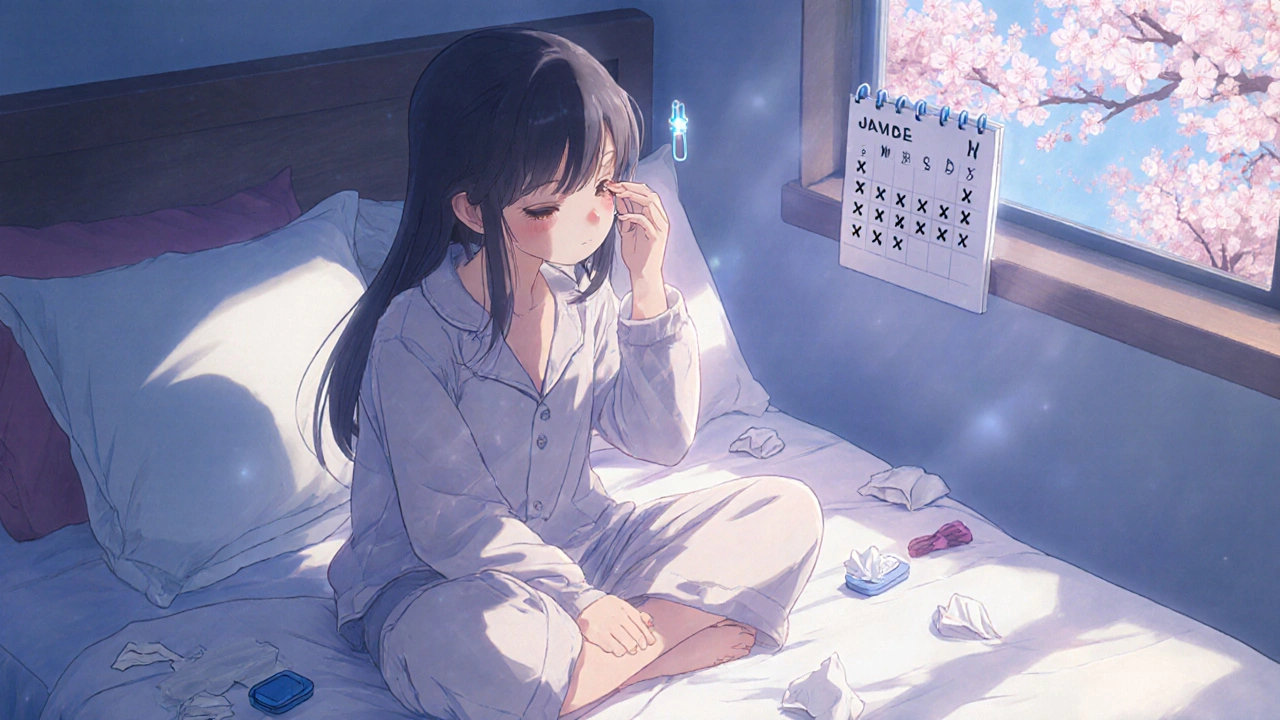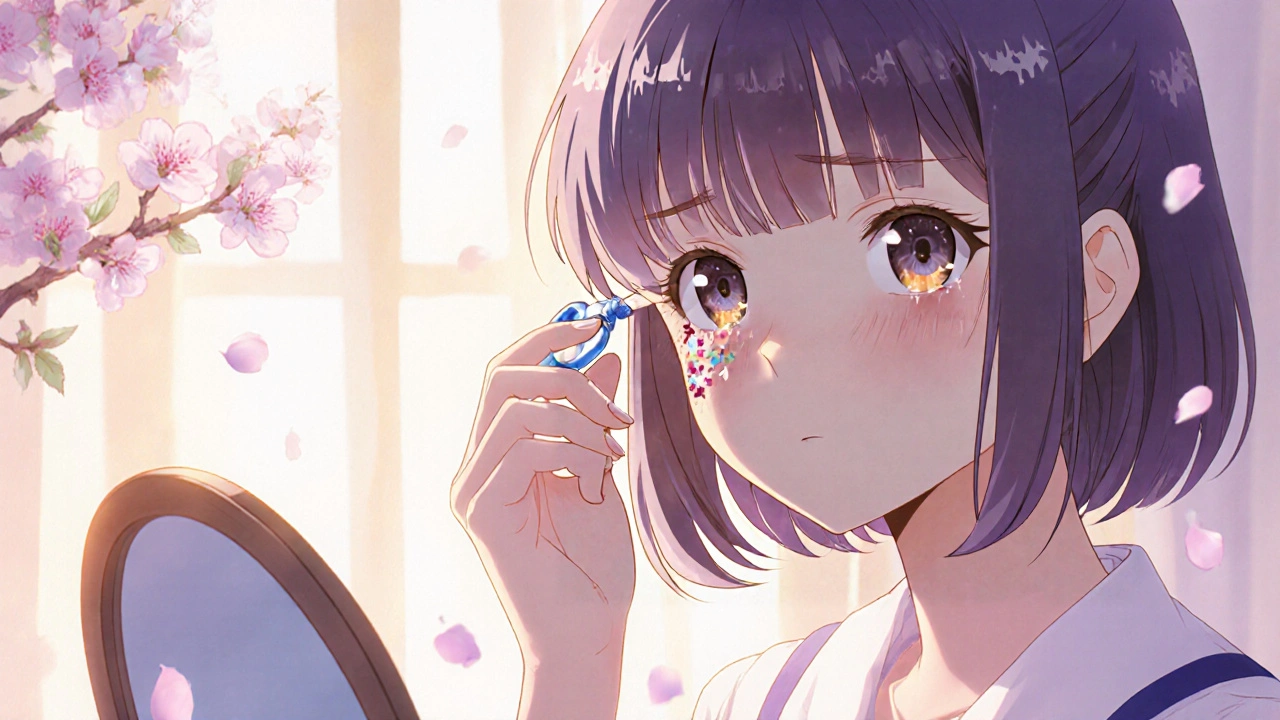If your eyes are red, gritty, and stuck shut in the morning, you’re not alone. Bacterial conjunctivitis-commonly called pink eye-affects millions each year. It’s contagious, uncomfortable, and often misunderstood. While viral pink eye clears on its own, bacterial conjunctivitis needs treatment. That’s where chloramphenicol eye drops come in.
What Is Chloramphenicol Eye Drops?
Chloramphenicol eye drops are a topical antibiotic designed to kill bacteria causing eye infections. First developed in the 1940s, they’re one of the oldest and most widely used antibiotics for eye infections. The active ingredient, chloramphenicol, works by stopping bacteria from making proteins they need to survive. Without those proteins, the bacteria can’t multiply or spread.
Unlike some newer antibiotics, chloramphenicol is broad-spectrum. That means it works against many types of bacteria, including Staphylococcus aureus, Streptococcus pneumoniae, and Haemophilus influenzae-the most common culprits behind bacterial conjunctivitis. It’s available as 0.5% eye drops and 1% eye ointment in most countries, including the UK, Australia, and parts of Europe.
It’s not sold over the counter in the U.S., but in places like the UK, you can buy it without a prescription under brand names like Chloramphenicol Optrex or Chloromycetin. That’s because it’s considered safe for short-term, self-limiting infections when used correctly.
How Does It Work Against Pink Eye?
Bacterial conjunctivitis isn’t just redness. It’s often accompanied by thick, yellow or green discharge, swelling, and a burning feeling. These symptoms happen because bacteria are multiplying on the surface of your eye, triggering inflammation.
Chloramphenicol eye drops penetrate the outer layers of the eye quickly. Once absorbed, they target the bacteria’s ribosomes-the tiny factories inside cells that build proteins. By blocking protein production, the antibiotic stops the infection from spreading. Within 24 to 48 hours, most people notice less discharge and reduced redness.
It doesn’t cure the inflammation directly. That’s why your eyes might still feel irritated even as the infection clears. But by killing the bacteria, your body’s natural healing process can take over. Studies show that chloramphenicol resolves bacterial conjunctivitis in about 85% of cases within a week.
When Should You Use It?
Not all pink eye is the same. You need to know what you’re treating before reaching for eye drops.
- Bacterial conjunctivitis: Thick discharge, usually starts in one eye and spreads to the other. Eyes may be crusted shut after sleeping. Lasts 7-10 days without treatment.
- Viral conjunctivitis: Watery discharge, often with cold-like symptoms. It’s contagious but doesn’t need antibiotics. Will clear on its own in 1-2 weeks.
- Allergic conjunctivitis: Itchy, watery eyes, often with sneezing or runny nose. Antihistamines help, not antibiotics.
Chloramphenicol eye drops are only effective for bacterial infections. Using them for viral or allergic pink eye won’t help-and could make things worse by promoting antibiotic resistance.
Signs you likely have a bacterial infection:
- Pus or mucus that’s yellow or green
- One eye affected first, then the other
- Symptoms lasting more than 3 days without improvement
- No recent cold or allergies
If you’re unsure, see a doctor. Misusing antibiotics is a growing global problem. The WHO lists chloramphenicol as a critically important antibiotic. It should be used wisely.

How to Use Chloramphenicol Eye Drops Correctly
Using eye drops wrong is one of the most common reasons treatment fails. Here’s how to do it right:
- Wash your hands. Clean hands prevent introducing more bacteria.
- Tilt your head back. Look up and gently pull down your lower eyelid to form a pocket.
- Hold the dropper close-but don’t touch your eye. One drop into the pocket. Close your eye for 30 seconds.
- Press the inner corner of your eye. Gently press where your eyelid meets your nose. This keeps the medicine in your eye longer and reduces absorption into your bloodstream.
- Wait 5 minutes between drops. If you’re using more than one type of eye drop, wait at least 5 minutes between each.
- Use every 3-4 hours. Typically, 1-2 drops in each affected eye, 4 times a day for 5 days.
Don’t stop using the drops just because your eyes feel better. Finish the full 5-day course-even if symptoms disappear after 2 or 3 days. Stopping early can let surviving bacteria come back stronger.
Side Effects and Risks
Chloramphenicol is generally safe for short-term eye use. But like all medications, it has risks.
Common side effects (mild and temporary):
- Burning or stinging when first applied
- Blurred vision (lasts a few minutes)
- Itchy or swollen eyelids
These usually go away as your eye adjusts. If they last more than a day or get worse, stop using the drops and see a doctor.
Very rare but serious risks:
- Bone marrow suppression (affects blood cell production)
- Aplastic anemia (life-threatening)
These are almost never seen with eye drops-they’re linked to oral or IV use over long periods. Still, people with blood disorders, liver disease, or those taking other medications that affect bone marrow should avoid chloramphenicol. Pregnant women and infants under 2 years old should only use it under medical supervision.
Always check the expiration date. Old or contaminated eye drops can cause serious infections. Never share eye drops with others.
Alternatives to Chloramphenicol
Chloramphenicol isn’t the only option. Other antibiotics used for bacterial conjunctivitis include:
| Medication | Active Ingredient | Typical Use | Pros | Cons |
|---|---|---|---|---|
| Chloramphenicol | Chloramphenicol | First-line for mild cases | Broad-spectrum, affordable, widely available | Rare risk of bone marrow suppression |
| Ofloxacin | Ofloxacin | More severe or resistant cases | Stronger against resistant bacteria | More expensive, requires prescription |
| Trimethoprim-Polymyxin B | Trimethoprim + Polymyxin B | Common in U.S. prescriptions | Lower systemic risk, good safety profile | Narrower spectrum than chloramphenicol |
| Tobramycin | Tobramycin | Gram-negative infections | Effective for Pseudomonas | Can cause irritation, not first choice |
For most healthy adults with mild bacterial conjunctivitis, chloramphenicol remains the best balance of effectiveness, cost, and availability. In the U.S., where it’s prescription-only, doctors often choose trimethoprim-polymyxin B instead.

What to Do If It Doesn’t Work
After 48 hours, you should see improvement. If your eye is still red, swollen, or producing thick discharge, or if you start feeling pain, light sensitivity, or vision changes, stop using the drops and see a doctor.
These signs could mean:
- The infection is viral or fungal (antibiotics won’t help)
- You have a more serious infection like keratitis
- You’re allergic to the drops
Don’t try doubling the dose or switching to another antibiotic on your own. That increases resistance risk and delays proper diagnosis.
Preventing Recurrence
Once you’ve had bacterial conjunctivitis, you’re more likely to get it again. Prevention is simple:
- Wash your hands often, especially before touching your eyes
- Don’t share towels, pillows, or eye makeup
- Replace your eye makeup after an infection
- Use clean tissues to wipe discharge-never reuse them
- Wash bedding and pillowcases in hot water
Children in daycare and people who wear contact lenses are at higher risk. If you wear contacts, switch to glasses until the infection clears. Don’t reuse old lenses or cases.
Final Thoughts
Chloramphenicol eye drops are a reliable, low-cost solution for bacterial conjunctivitis. They work fast, are easy to use, and have decades of real-world use behind them. But they’re not magic. They only work if used correctly and only for the right type of infection.
Use them when you’re sure it’s bacterial. Finish the full course. Watch for side effects. And if things don’t improve, don’t guess-get help.
Most cases clear up without complications. But eyes are delicate. Treating them with care means protecting your vision-for good.
Can I use chloramphenicol eye drops for viral pink eye?
No. Chloramphenicol only kills bacteria. Viral pink eye is caused by a virus and will clear on its own in 1-2 weeks. Using antibiotics for viral infections doesn’t help and can contribute to antibiotic resistance.
How long does it take for chloramphenicol eye drops to work?
Most people notice improvement within 24 to 48 hours. Redness and discharge should start to decrease. If there’s no change after 2 days, or if symptoms worsen, stop using the drops and see a doctor.
Can children use chloramphenicol eye drops?
Yes, but with caution. Children under 2 years old should only use chloramphenicol under a doctor’s supervision due to a rare risk of bone marrow suppression. For older children, it’s generally safe for short-term use when used as directed.
Is it safe to use chloramphenicol eye drops while pregnant?
Topical use in pregnancy is considered low risk, but not risk-free. Small amounts can be absorbed into the bloodstream. Always consult a doctor before using any medication during pregnancy. There are safer alternatives available if needed.
Can I wear contact lenses while using chloramphenicol eye drops?
No. Remove your contact lenses before using the drops and don’t put them back in for at least 15 minutes. During treatment, it’s best to switch to glasses. Contacts can trap bacteria and delay healing. Replace your lenses and case after the infection clears.
Where can I buy chloramphenicol eye drops?
In the UK, Australia, Canada, and many European countries, you can buy chloramphenicol eye drops over the counter at pharmacies. In the U.S., it requires a prescription. Always check local regulations and buy from licensed pharmacies to avoid counterfeit products.
What happens if I miss a dose?
If you miss a dose, apply it as soon as you remember. If it’s almost time for your next dose, skip the missed one. Don’t double up. Consistent dosing every 3-4 hours is key to keeping enough medicine in your eye to kill the bacteria.
Can chloramphenicol eye drops cause blurry vision?
Yes. Temporary blurry vision is common right after applying the drops. It usually clears within a few minutes. Don’t drive or operate machinery until your vision returns to normal. This is a side effect of the liquid in the eye, not a sign of damage.


Malia Blom
November 4, 2025 AT 17:12Look, I get it - chloramphenicol’s cheap and works, but we’re basically treating pink eye like it’s 1978. In the US, we have better, safer options. Why are we still using a drug that can literally shut down your bone marrow? It’s not ‘widely used’ - it’s just not regulated enough. We’re playing Russian roulette with antibiotics because someone decided ‘it’s fine for eyes’ and now everyone’s a DIY pharmacist. 🤷♀️
Erika Puhan
November 5, 2025 AT 03:01The pharmacokinetic profile of chloramphenicol is suboptimal for ocular bioavailability, especially when compared to fluoroquinolones like ofloxacin, which demonstrate superior tissue penetration and lower resistance induction. The empirical use of broad-spectrum agents in self-limiting conditions contributes to the global AMR crisis - a phenomenon that, according to WHO, could lead to 10 million annual deaths by 2050 if unmitigated. You’re not ‘saving time’ - you’re accelerating collapse.
Edward Weaver
November 5, 2025 AT 12:55USA makes better antibiotics. We don’t need some old-school Soviet-era crap from the UK. Ofloxacin? Better. Trimethoprim-polymyxin? Better. Chloramphenicol? Only used by people too lazy to drive to a clinic. If you’re in America, you want a prescription - not some pharmacy shelf drug that’s banned in half the developed world. We’re better than this.
Lexi Brinkley
November 6, 2025 AT 11:11Just used this after my dog sneezed on me 😅 and it worked like magic! Redness gone in 2 days! No more crusty eyes in the morning 🙌 also, i replaced all my makeup and towels bc i’m not a slob 💅🧼
Kelsey Veg
November 6, 2025 AT 16:30so like… i got pink eye and i bought the chloramphenicol drops at walgreens? wait no, they dont sell it here?? so i ordered it off amazon from some uk site?? is that safe?? idk but my eyes dont burn as bad now so i guess its working??
Alex Harrison
November 7, 2025 AT 15:16Been using this for years. Just follow the directions. Wash hands, don’t touch the dropper, finish the whole bottle even if it feels better. I used to skip the last couple days and then it came back worse. Don’t be that guy. Also, replace your contacts. Always. I learned the hard way.
Jay Wallace
November 8, 2025 AT 03:01Let me just say - the fact that this is even available OTC in the UK is a testament to their systemic collapse of medical standards. In America, we require a prescription for a reason: liability, safety, and professional oversight. You think you’re being ‘practical’ by buying it online? You’re just another statistic waiting to happen. And don’t get me started on the ‘replace your makeup’ advice - that’s basic hygiene, not medical wisdom.
Alyssa Fisher
November 9, 2025 AT 07:07It’s interesting how we treat eye infections as trivial, but eyes are literally the most delicate organ we have. Chloramphenicol’s mechanism - inhibiting bacterial ribosomes - is elegant in its simplicity, but the risk-benefit calculus changes when you consider that humans have been using this since the Cold War. We’re not just treating an infection; we’re participating in a centuries-old arms race with microbes. Maybe the real question isn’t whether it works - but whether we’re still morally entitled to use it, given how much we’ve abused antibiotics.
Alyssa Salazar
November 10, 2025 AT 15:20Okay but why is everyone acting like chloramphenicol is some dangerous demon? It’s a topical antibiotic - 0.5% concentration, applied locally. The systemic absorption is negligible. Meanwhile, you’re all panicking about bone marrow suppression like it’s a guaranteed side effect. Meanwhile, you’re popping ibuprofen like candy and never thinking twice. Pick your poison. This is still the most effective, cheapest, most accessible option for mild bacterial conjunctivitis. Stop the fearmongering.
Beth Banham
November 11, 2025 AT 03:07Thanks for the clear info. I’ve had pink eye twice and both times I just assumed it was viral and waited it out. This helped me realize I might’ve made it worse by not treating it properly. Going to keep this saved for next time. Also, replacing makeup? That’s a good reminder - I never thought about that.